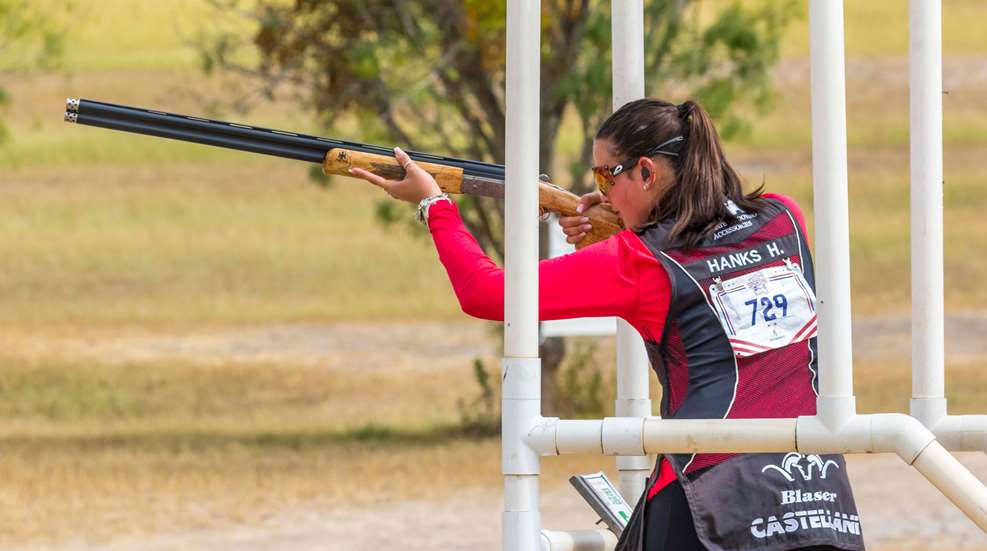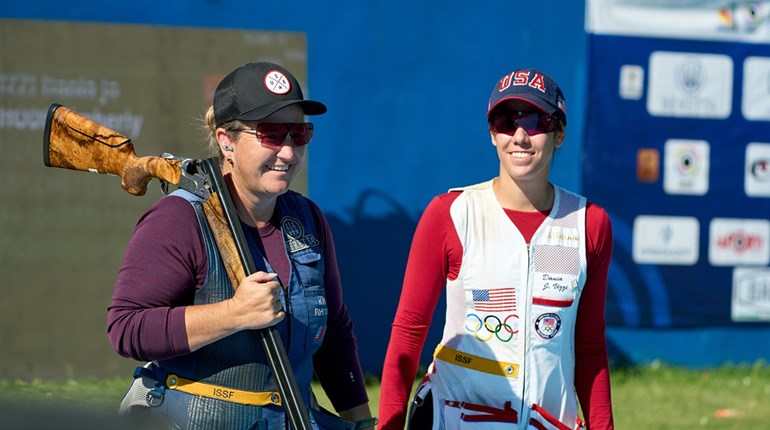
There are several compelling reasons to take up a shotgun sport. They’re all great practice for wingshooting, if you’re a hunter. They’re social events you can do with friends or on a team or squad, and of course, they’re just plain fun. There are three major shotgun sports in the U.S. and a handful of off-shoots of each one. The Big Three, though, are trap, skeet and sporting clays. By all means, try all of them. But how do you know which is most likely to suit you?
Trap
American trap is shot on a sort of curved triangle-shaped field, often overlayed on a half-moon-shaped skeet field. Shooters stand side by side at five stations on the wide side of the triangle, and the targets come from a single trap house 16 yards in front of them, directly in the middle (the point of the triangle). The targets emerge from the same spot and fly away from the field, but they could fly at any angle within a specific safe range. This, combined with the fact that shooters move from one station to another, means the angles are constantly changing, although the height of the targets will stay the same. As you improve, you “handicap” by moving back so the shots are farther. Shooters typically use a swing-through method to break trap targets, where the shooter starts the muzzle behind the target, swings past the target and pulls the trigger.

Wikipedia Commons Image Credit
Trap is very popular and is a fast-growing youth sport in many parts of the country. Trap shooters tend to be serious and quiet. They’re having fun, but there’s little to no talking during a round. It’s all about the rhythm of the squad, and you don’t want to be the one to slow it down.
Trap might be for you if: You want challenging, somewhat unpredictable shot angles and you really appreciate serious, regimented competition. If you’re all fun and games until it’s time to shoot and then you put on your hard-core game face, trap might be your sport.
Skeet
American skeet is shot on a half-moon-shaped field. A squad of shooters all shoots the same station before moving on to the next, rotating around the curve of the half-moon for seven stations, with station eight in the middle of the flat part of the half-moon. Targets come from each side, with a trap house at either “corner” of the half-moon, and the house on the left throws higher targets than the house on the right. Every American skeet field has the exact same dimensions and throws targets at the exact same angle—so although the background might change, a game of skeet in Florida is exactly the same as a game of skeet in Colorado.

Images courtesy National Skeet Shooting Association (NSSA)
Although each station offers different angles, each target should fly the same way (give or take a bit due to wind), making skeet a very learnable, repeatable game. It’s the same thing every time, and for this reason, skeet is often called “a game of perfection.” This is not to imply that skeet is easy or simple, but at major competitions, multiple shooters might shoot perfect scores, requiring many tie-breaking shoot-offs at the end of the day. Because of this striving for perfection, skeet shooters put a great deal of emphasis on the mental aspect of their game.
Skeet can be shot with the swing-through method, but sustained or maintained lead is more common: The shooter starts with the muzzle in front of the target and swings it ahead of the target, matching the speed of the muzzle with the speed of the target, maintaining the lead. They then trigger the shot when they think the lead is correct.

Skeet is fairly serious, but less so than trap. Squadmates might high-five and congratulate each other after they shoot a station, but there is generally no loud whooping or cheering, and shooters don’t like to be distracted while they are on the shooting pad preparing to call pull.
Skeet might be for you if: You enjoy the pursuit of perfection but won’t beat yourself up if you can’t achieve it, and if you like knowing exactly what you’re about to see every time you shoot. If you’re looking for a mental challenge, skeet might be the ticket, because it takes serious discipline to do the exact same thing in the exact same way every time.
Sporting Clays
Sporting clays is the young and carefree sister of this bunch. It’s only been in the U.S. for about 40 years, which makes it much newer than skeet and trap. It’s known as “golf with a shotgun” for a reason—rather than being set on a fixed-size field like skeet and trap, sporting clays is shot on a course, and shooters travel (often in a golf cart) between stations to shoot the entire course. Sporting clays stations can be in the woods, in open fields, over water, or even elevated on platforms. Targets can come from nearly anywhere and fly in nearly any direction, making this game unpredictable—you might be shooting 15 yards or 50 yards, below your feet or above your head, crossers or going-away targets or straight-up-in-the-air teal. There are even bounce-along-the-ground targets called rabbits. No two sporting clays courses in the world are exactly alike, and your local course will probably changes its targets every few weeks to create a whole new experience.

National Sporting Clays Association Image
Shooters get to view at least one “show pair” before they shoot the station, so they know where the targets are coming from and where they’re going. Then they quickly make a plan for how to break the targets, step up and call pull. Sometimes targets are shot as singles and sometimes as pairs, either simultaneous/true (both targets launched at the same time) or report pairs (second target is launched when the gun is fired at the first target). Good shooters use different methods—swing-through, sustained-lead, intercept and more—on different sporting clays targets depending on what makes the most sense given the target’s flight path.
Perfect scores on good, competitive sporting clays courses are rare, so perfection is not the expectation. Sporting clays shooters enjoy figuring out how to approach a given target presentation, perhaps one they’ve never seen before, and they typically get to shoot each target at least two or three times on the station, so if they miss the first time, they can adjust their plan for the next shot. It’s a problem-solving game. Sporting clays tends to be a much more social sport than skeet or trap. Shooters will talk, joke around, cheer for each other and razz on each other all through a round, and distractions are considered just a part of the game you have to deal with.
Sporting clays might be for you if: You enjoy challenging puzzles and like figuring things out, and you’re looking for competition with a side of fun. If the social aspect of shooting is a priority for you and you wouldn’t enjoy shooting in a serious, quiet atmosphere, sporting clays is probably for you.















































